
The Masonic Temple in Downtown Berkeley, California is a historic building listed on the National Register of Historic Places. It is located at 2105 Bancroft Way at the corner of Shattuck Avenue, just one block west of the University of California, Berkeley. The Classical Revival style building, designed by William H. Wharff, was built in 1905. The building was built for Berkeley's Masons, who started a local lodge in 1882 and formed the Berkeley Masonic Temple Association to build the temple. In 1944, the building was converted to a bank. The ground floor of the building was unoccupied and the remaining floors were used by University staff, including the California Center for Innovative Transportation and the National Writing Project.


The Tripoli Shrine Temple is a Shriners temple built 1926-28 in the Concordia neighborhood of Milwaukee, Wisconsin. The building's design incorporates Moorish and Indian elements, somewhat resembling the Taj Mahal in India, and is listed on the National Register of Historic Places as Tripoli Temple. It is not a religious building.

The Masonic Temple is a historic Masonic building in Philadelphia. Located at 1 North Broad Street, directly across from Philadelphia City Hall, it serves as the headquarters of the Grand Lodge of Pennsylvania, Free and Accepted Masons. The Temple features the Masonic Library and Museum of Pennsylvania, and receives thousands of visitors every year to view the ornate structure, which includes seven lodge rooms, where today a number of Philadelphia lodges and the Grand Lodge conduct their meetings.
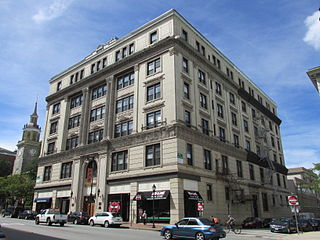
The Masonic Temple is a historic commercial and fraternal society building at 415 Congress Street in downtown Portland, Maine. Built in 1911 to a design by local architect Frederick A. Tompson, it is one of the city's finest examples of Beaux Arts architecture, and houses some of the state's grandest interior spaces. It was listed on the National Register of Historic Places in 1982.

The Masonic Temple is a historic Masonic temple in the village of Mechanicsburg, Ohio, United States. Built in the 1900s for a local Masonic lodge that had previously met in a succession of buildings owned by others, it is the last extant Mechanicsburg building constructed for a secret society, whether Masonic or otherwise, and it has been designated a historic site because of its well-preserved American Craftsman architecture.
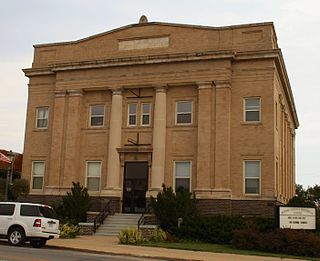
The Boone History Center, previously known as the Champlin Memorial Masonic Temple, is a historic building in Boone, Iowa. Constructed in 1907 as the Champlin Memorial Masonic Temple, the building housed Mt. Olive Lodge No. 79 until 1990. It now houses the Boone County Historical Society.
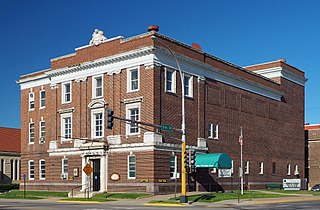
The Winona Masonic Temple is a historic Masonic Temple in Winona, Minnesota, United States, completed in 1909. Many local civic and business leaders were members of the lodge. Containing a large ballroom and other meeting space, the building was an important venue in Winona for both Masonic activities and general public events. The Winona Masonic Temple was listed on the National Register of Historic Places in 1998 for having state-level significance in the themes of art and social history. It was nominated as the headquarters of a fraternal organization important to Winona's civic and social development, and for containing Minnesota's largest collection of Masonic theatre backdrops and stage equipment.

The Monroe County Museum is a historic building located in Sparta, Wisconsin. It was constructed in 1923 as a meeting hall for a local Masonic Lodge, and was listed on the National Register of Historic Places in 1987 under the historic name "Sparta Masonic Temple".

The Masonic Temple Building in Viroqua, Wisconsin was built in the Classical Revival style. It was designed by architects Albert E. Parkinson and Bernard Dockendorff and was listed on the National Register of Historic Places in 2000.
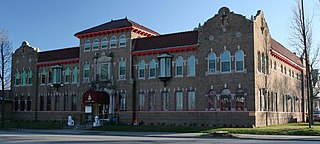
The Pythian Castle Lodge, also known as Crystal Palace, in Milwaukee, Wisconsin, United States, was built in 1927 by the Knights of Pythias, a fraternal organization. In 1988 it was listed on the National Register of Historic Places.

The Godwin–Knowles House is a historic former house in downtown East Liverpool, Ohio, United States. A Colonial Revival structure built in 1890, it has played important parts both in the city's industry and in its society.

The Wisconsin Consistory Building, also known as the Humpfrey Scottish Rite Masonic Center, is a historic structure in Milwaukee, Wisconsin that was built as a Romanesque-style Congregational church in 1889, then bought by a Masonic order and remodeled to an Art Moderne style in 1937. In 1994 it was listed on the National Register of Historic Places.

The Oregon Masonic Hall or Oregon Masonic Lodge is a highly-intact 1898 building in Oregon, Wisconsin - with the second story finely decorated using cream and red brick and red sandstone. It was listed on the National Register of Historic Places in 1992.
Clarence Hatzfeld (1873–1943) was a prolific Chicago architect who designed residences, park field houses, Masonic temples, banks and other commercial buildings in the Craftsman, Prairie, and Revival styles.
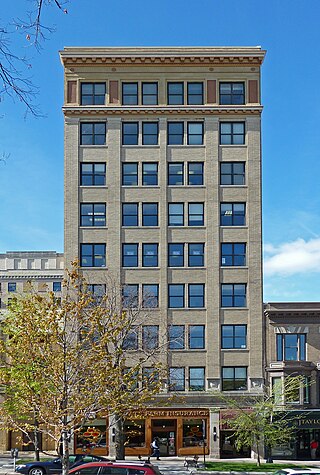
Law, Law & Potter was an architecture firm in Madison, Wisconsin; Potter Lawson, Inc. is its modern-day successor. Some of its buildings are listed on the U.S. National Register of Historic Places for their architecture. The firm was Madison's largest and "arguably most important" architectural firm in the 1920s and 1930s.

Frank M. Riley was an architect of Madison, Wisconsin. A number of his works are listed on the National Register of Historic Places for their architecture.

The Huron Street Historic District is located in Berlin, Wisconsin.

The New England Masonic Charitable Institute is a historic building on Town House Road in Effingham, New Hampshire. It was listed on the National Register of Historic Places in 2019, and the New Hampshire State Register of Historic Places in 2002.




















